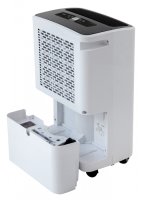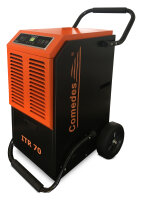Building dryer - when to use it?
Application profile of comedes dehumidifiers
| Room Dryer/ Building Dryer Type | Use in living rooms | Use in the basement | Use for drying the home (new construction). | Use for drying several houses | Use for drying in case of water damage |
|---|---|---|---|---|---|
| Comedes Demecto 10 | +++ | ++ | + | 0 | + |
| Comedes LTR 100 Neo | +++ | ++ | + | 0 | + |
| Comedes Demecto 30 ECOI | +++ | +++ | ++ | 0 | ++ |
| Comedes Demecto 70 | ++ | +++ | +++ | 0 | +++ |
| Comedes BTR 50 | + | +++ | +++ | + | +++ |
| Comedes BTR 70 | + | +++ | +++ | ++ | +++ |
The advantages of a construction dryer
Building dryers are particularly powerful dehumidifiers. They can remove large amounts of moisture from the air in a short time. In addition to the dehumidification performance, the robust design is the main reason for choosing one of the devices. This ensures that the dryer can be operated continuously without the need for constant monitoring. In addition, the design guarantees the longevity of the device.
How does a building dryer work?
Drying works via the so-called heat pump principle. With this, the air enriched with moisture is first sucked in. This is done by a fan. If a filter is part of the device, it also acts as an air purifier at the same time. In this case, the moist air inside the dryer is first filtered and then cooled. The moisture particles in the air condense by lowering the temperature and are collected in a tank as water or diverted to the drain. The air that has been dehumidified in this way is heated by the heat of condensation, as well as the waste heat from the fan and compressor. As a result, the air is warmer when it leaves the unit than when it enters, similar to what happens with a heat pump.
Which model for water damage restoration?
In the event of water damage, the BTR 50 is particularly suitable for remediation. This offers various settings for operation. It can be switched on and off by timer and used in continuous or automatic mode. Thanks to overflow protection and unbreakable water tank, this room dehumidifier can also be operated without supervision.
Thanks to the metal housing, the BTR 50 is also particularly resistant and can be used in adverse environments, such as after a flood. In addition to its function as a dehumidifier, the device also acts as an air purifier, which makes it a good choice on construction sites.
Up to 51 liters of moisture can be removed from the air per day with the BTR 50, making the dryer ideally suited for larger tasks. In doing so, it dehumidifies rooms up to 50 m² and can keep rooms up to 100 m² dry. The water tank holds 5.5 liters.
How long does a wall need to dry after water damage?
The time required for drying depends on various factors. A dryer with a high dehumidification capacity, for example, delivers better results than a device with a lower capacity. The volume of the area to be dried and the surrounding temperature also have an influence, as does the material, since it can absorb different amounts of water. A cubic meter of brick, for example, stores up to 180 liters of water. Every day, only a fraction of this amount can be removed from the masonry with the help of a dehumidifier. Therefore, a minimum drying time of four to six weeks should be assumed.
Temperature also leads to differences in performance. In addition, not all dryers work at all temperatures.
Since warm air absorbs more moisture than cold air, we advise heating the room during the winter months. A difference of only 10° Celsius can result in twice the amount of moisture being absorbed. To achieve an optimal temperature, a fan heater can be used. A room temperature of 15° Celsius and above is recommended.
In order to guarantee efficient operation of the dehumidifier and thus the shortest possible drying time, the dryer should be supplemented with a fan in addition to the fan heater. This ensures the circulation of air in the room. As a result, the air absorbs moisture from the area to be dried more quickly, which accelerates the drying process by up to thirty percent.
| Type | Dehumidification capacity (30°C/80% LF) | Power setting | Drying time |
|---|---|---|---|
| Demecto 10 | 10l/Day | CO | 2 Weeks |
| LTR 100 Neo | 12l/Day | CO | 2 Weeks |
| Demecto 30 ECOI | 25l/Day | CO | 1 Week |
| Demecto 70 | 70l/Day | CO | 3 Days |
| Comedes BTR 50 | 50l/Day | CO | 4 Days |
| Type | Dehumidification capacity (30°C/80% LF) | Power setting | Drying time |
|---|---|---|---|
| Demecto 10 | 10l/Day | CO | 6 Weeks |
| LTR 100 Neo | 12l/Day | CO | 6 Weeks |
| Demecto 30 ECOI | 25l/Day | CO | 4 Week |
| Demecto 70 | 70l/Day | CO | 1 Day |
| Comedes BTR 50 | 50l/Day | CO | 1,5 Day |
Rent or buy a construction dryer?
Room dehumidifiers are often only needed for a specific situation. If, for example, water damage has occurred due to a burst pipe, the device should be used to dry the corresponding premises and prevent dangerous consequences such as mold or sponge formation. If otherwise no room dehumidifier is needed, the question arises whether it is worth buying a device for this purpose or whether renting is more cost-effective. To decide this, the drying time and the prices for buying or renting are decisive.
A unit like the BTR 50 can be purchased new for 629 Euros. Assuming a minimum drying time of four to six weeks, renting a unit should not exceed 15 euros per day. Since the average rental price is between 8 and 30 EUR, this is quite possible in practice. If the drying period is longer, the purchase of the device is more worthwhile.
Moreover, one should not disregard the possibility of reselling the dryer afterwards. In this way, at least one or two hundred euros of the purchase price can be recouped. This greatly reduces the cost of the purchased dehumidifier and makes it difficult to obtain a unit for a lower rental price. Of course, there is also the option to buy the dryer used. This way, the price of the purchase is less. Of course, this does not affect the option to resell it afterwards.
In any case, you should buy if it is not a temporary situation such as water damage restoration, but instead an often damp room such as a basement should be regularly dehumidified. Under these circumstances, it makes sense to purchase a unit that can be used over and over again for years to come. Over time, the purchase will pay off significantly compared to renting, especially if a used unit was chosen anyway.
Damp rooms can also be considered if the dehumidifier was actually intended for the restoration of water damage. After all, once purchased, the device can subsequently be used for dehumidification of other premises. This makes the purchase all the more worthwhile.
In a nutshell: Buying is worthwhile if ...
the water damage is not covered by insurance
a restoration company would charge for the drying device according to daily rates
you would like to do most of the restoration yourself
there is a major water damage
In a nutshell: Renting is worthwhile if ...
the water damage is covered by insurance anyway (check the insurance conditions!)
a company offers the drying service within the scope of the renovation










